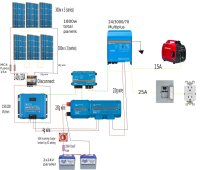fisherman
New Member
Good Morning,
I'm planning on adding solar to my cottage which is completely off grid. I'm trying to build it so I can scale out additional panels and batteries as needed. I really like the Victron line so I'm planning the below layout. I've done a power audit and will eventually need more batteries, but I'm hoping I'm on the right track. I'm looking for general feedback and also had a few questions.
1. What devices should I be grounding to earth?
2. If I'm using a Honda floating neutral generator to supplement the inverter/charger, is the bonded neutral/ground on the panel sufficient/correct?
3. Are there any additional fuses or components I should consider with this layout; aside from more batteries?
4. Is there a UL/CSA approved solar disconnect/combiner box? If not what are some good brands to consider? I'd need something that can handle 140v.
Thanks in advance.
I'm planning on adding solar to my cottage which is completely off grid. I'm trying to build it so I can scale out additional panels and batteries as needed. I really like the Victron line so I'm planning the below layout. I've done a power audit and will eventually need more batteries, but I'm hoping I'm on the right track. I'm looking for general feedback and also had a few questions.
1. What devices should I be grounding to earth?
2. If I'm using a Honda floating neutral generator to supplement the inverter/charger, is the bonded neutral/ground on the panel sufficient/correct?
3. Are there any additional fuses or components I should consider with this layout; aside from more batteries?
4. Is there a UL/CSA approved solar disconnect/combiner box? If not what are some good brands to consider? I'd need something that can handle 140v.
Thanks in advance.
Attachments
Last edited:



